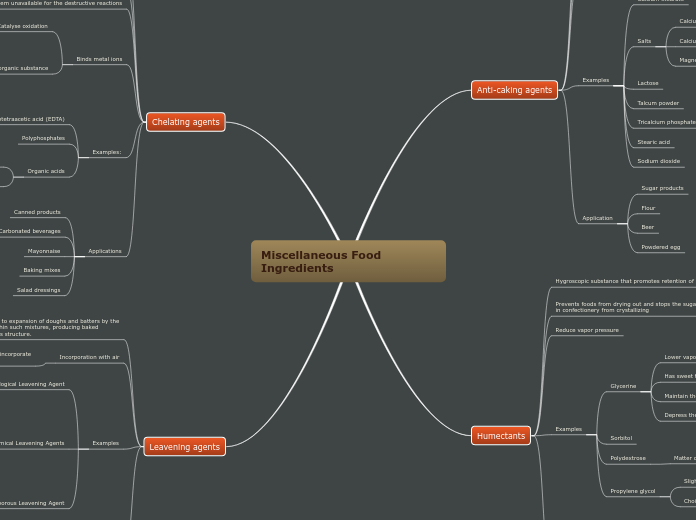Miscellaneous Food Ingredients
Anti-caking agents
Used to prevent the formation of lumps and for easing packaging, transport, and consumption
Absorb excessive moisture
Additives present in many commercial salts
Examples
Calcium stearate
Salts
Calcium silicate (CaSiO3)
Calcium carbonate
Magnesium carbonate
Lactose
Talcum powder
Tricalcium phosphates
Stearic acid
Sodium dioxide
Application
Sugar products
Flour
Beer
Powdered egg
Humectants
Hygroscopic substance that promotes retention of water
Keep products moist
Bind the moisture that is contained in the food and and absorb moisture from the air
Prevents foods from drying out and stops the sugar contained in confectionery from crystallizing
Reduce vapor pressure
Examples
Glycerine
Lower vapor pressure of food
Has sweet taste
Maintain the softness of products
Depress the freezing point of food
Sorbitol
Polydextrose
Matter of taste
Propylene glycol
Slightly bitter taste
Choice for strongly flavoured products
Application
Dried fruits
Jellies
Jam
Frozen dessert
Chelating agents
Food additives that prevent oxidation and increase shelf life of baked goods
Bind with metal ions for making them unavailable for destructive reactions
To make them unavailable for the destructive reactions
Binds metal ions
Catalyse oxidation
Combine with organic substance
Cause discoloration
Off-flavor
Formation of struvite crystal
Examples:
Ethylenediaminetetraacetic acid (EDTA)
Very low usage level make it more effective
Polyphosphates
Organic acids
Citric
Tartaric
Applications
Canned products
Carbonated beverages
Mayonnaise
Baking mixes
Salad dressings
Leavening agents
Substance that lead to expansion of doughs and batters by the release of gases within such mixtures, producing baked products with porous structure.
Agents such as air, steam, yeast, baking
powder and baking soda
Incorporation with air
Achieved by vigorous mixing incorporate
air bubbles producing foams
Examples
Biological Leavening Agent
Yeast
Chemical Leavening Agents
Baking Soda and Baking Powder
Single-acting baking powders
Containing tartaric acid or cream of tartar
Slow-acting baking powders
Containing phosphates
Double-acting baking powders
1st action
Gas is released when baking soda
in powder react with acidic liquid.
2nd action
Gas is released when batter is heated in oven or on a griddle
Vaporous Leavening Agent
Steam
Applications
Bread
Cake
Cookies
